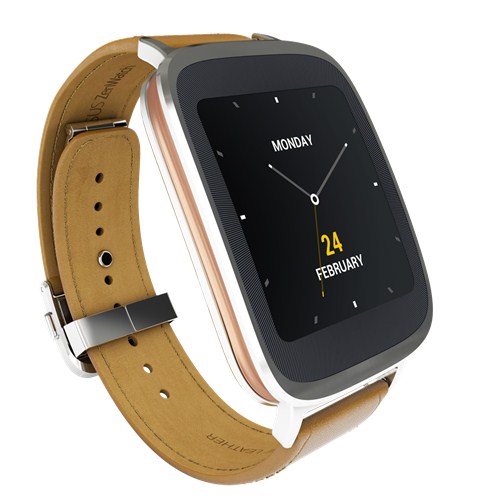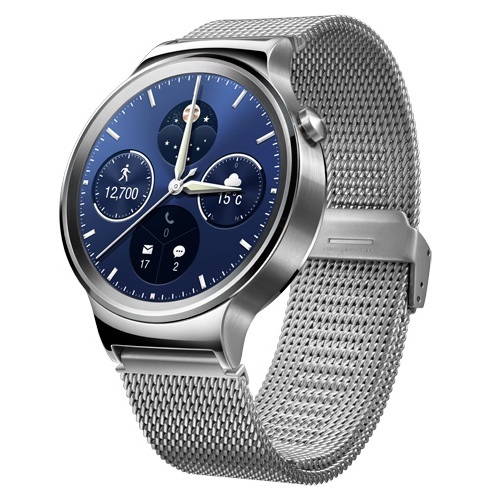 Much to the delight of Apple fanbots everywhere, Apple has now fully unveiled the Apple Watch. The watch, which was previewed in September, will go on sale April 10 and ship on the 24th. Based on its brand name, styling, accessories, and battery life claims, it will likely be a big hit — at least as far as smartwatches go.
Much to the delight of Apple fanbots everywhere, Apple has now fully unveiled the Apple Watch. The watch, which was previewed in September, will go on sale April 10 and ship on the 24th. Based on its brand name, styling, accessories, and battery life claims, it will likely be a big hit — at least as far as smartwatches go.
According to Canalys, only 720,000 Android Wear smartwatches shipped in 2014 from about a half dozen manufacturers, out of a total of 4.6 million “smart wearable bands.” Yet, the first models shipped in the summer, and several second-generation models didn’t make it until later in the year or 2015. There are also a few new contenders. Our slide show of seven compelling Android- and Linux-based smartwatches features five Android Wear models, plus Tizen and WebOS-based watches (click on the Gallery link below).
Android Wear software features have improved somewhat since the launch, and the hardware specs have begun to creep upwards too, although Google’s guidelines somewhat limit innovation. Most of the watches follow the same script: a dual-core, 1.2GHz Qualcomm Snapdragon 400 with 512MB RAM and 4GB of eMMC flash, and a 1.63-inch, 320 x 320 AMOLED touchscreen. Most integrate Bluetooth 4.0, a micro-USB port, a microphone, various sensors, and voice control.
Such low-end specs limit the Wow factor, but Google realizes that on a tiny device like a smartwatch, a feature war could make the devices more expensive and harder to use. More features also leads to greater size and weight, potentially reversing recent style gains.
Some Android- and Linux-based watches outside of the Android Wear program push the envelope on more autonomous features rather than simply acting as a smartphone notification companion. This typically results in larger, clunkier designs that might look out of place in the boardroom or country club. On the other hand, they provide interesting functionality aside from health monitoring and the convenience of not having to reach into your pocket for your phone.
 While most of the early full-featured wrist smartphones, such as the Android-based Neptune Pine and the Omate TrueSmart, suffered in reviews, newer models such as LG’s Urbane Watch LTE seem more promising. The 4G-ready phone watch offers an innovative GUI that runs on a version of the Linux-based WebOS. Meanwhile, Neptune is expected to unveil a new wearable within the week.
While most of the early full-featured wrist smartphones, such as the Android-based Neptune Pine and the Omate TrueSmart, suffered in reviews, newer models such as LG’s Urbane Watch LTE seem more promising. The 4G-ready phone watch offers an innovative GUI that runs on a version of the Linux-based WebOS. Meanwhile, Neptune is expected to unveil a new wearable within the week.
Android Wear may not be setting the world on fire, but it still has a shot against the much vaunted Apple Watch. Unlike the original iPhone or iPad, the Apple Watch breaks little new ground. Or rather, it doesn’t add many more innovations than have any of the second- or third-generation Android Wear models. With most of these devices moving to round-faced screens and thinner watch-faces, the Apple Watch seems a bit pedestrian.
Round displays are more appealing to consumers, suggests Canalys. Its smartwatch study calls out the first round-faced Android Wear watch — the Moto 360 — as “the clear leader” among Android Wear watches, and notes that LG’s second-generation, round-faced LG G Watch R sold much better than the original G Watch.
Not surprisingly, Apple is pricing its watch on the high end. The Apple Watch starts at $349 for the sports model, but many of Apple’s typically well-heeled customers will likely choose the stainless steel options that bring the price up to $550 or more. There’s even a gold, luxury model that costs as much as $17,000, even though it is functionally the same as the sports model.
The Huawei Watch, which was widely considered the most attractive new watch unveiled at Mobile World Congress earlier this month, is also aiming high. The watch will likely start at around 349 Euros ($370 at the moment), according to some pre-order retail listings, although some models could cost as much as $1,000.
Most of the Android Wear watches cost much less at between $200 to $300, which could be seen either as an advantage or a disadvantage. Over the last two decades as wristwatches have gradually faded away as a mainstream fashion accessory, the market has been split into high-end luxury watches costing over $1,000 and low-end fitness watches under $100. There’s a danger that Android Wear might be stuck in a dead zone between the Apple Watch and other luxury smartwatches on the high end and the $99 and up Pebble and other basic notification and fitness watches.
The Pebble alone has sold over one million units since it launched in 2013, or about a fifth of all smart wearables, according to Canalys. A small army of 25,000 developers has developed some 6,000 apps and watch-faces for the fitness oriented Pebble. The fairly open SDK provides access to a firmware stack built on the open source FreeRTOS combined with proprietary code.
Our slide show is limited to watches that have been fully announced and are expected to ship by summer. Some watches that are farther off on the horizon show promise, however, like the Tizen- and Intel Edison-based Blocks watch, which brings some of the modular upgrade concepts used by the Project Ara phone to a smartwatch. Due to ship in late 2015, Blocks uses the links of the watch wristband to house modular components, which also helps reduce the size of the watch-face.
Some are calling Monohm’s large, disc-shaped Runcible a watch, even though it mimics smartphone features and is designed more for the pocket than the wrist. The autonomous, phone-like device, which runs on Firefox OS, is due in Japan by year’s end.
Then there are the leaked watches such as a round-faced, Tizen-based Samsung Orbis, which would replace the Samsung Gear S. A no-show at MWC, the Orbis is said to feature both a crown-shaped power button and a rotating bezel ring on top, somewhat like the Apple Watch.
HTC was also expected to unveil a smartwatch at MWC, but like Samsung, the company may have decided to wait for the Apple Watch instead. Well, time’s up!

